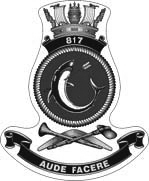- Author
- A.N. Other
- Subjects
- Naval Aviation
- Tags
-
- RAN Ships
- 817 Squadron, HMAS Melbourne II, HMAS Sydney III
- Publication
- December 2011 edition of the Naval Historical Review (all rights reserved)

This short history has been assembled from Squadron records.
817 Squadron has its origins in the Royal Navy (RN) where it was commissioned as a torpedo/reconnaissance squadron at Royal Naval Air Station (RNAS) Crail, Scotland on 15 March 1941. The Squadron served in Norway, Biscay, North Africa and Sicily primarily as a patrol unit for anti-submarine operations but was also used for torpedo and bombing missions against enemy ports and shipping. The Squadron disbanded on 23 August 1945.
817 Squadron re-commissioned as a Royal Australian Naval Air Squadron at RNAS St Merryn, Cornwall on 25 April 1950. Equipped with Fairey Firefly AS.6 aircraft and commanded by LCDR Ronald Lunberg, RN, 817 Squadron formed part of the 21st Carrier Air Group (CAG) along with 808 Squadron.
21st CAG began carrier qualifications aboard HMAS Sydney in April 1951. On 14 May, 817 Squadron were advised that they would form part of a new Sydney Carrier Air Group under the command of Commander (later Vice Admiral Sir) Mike Fell, RN, and deploy to Korea later that year. New pilots, many straight out of training, hurriedly converted to local operating procedures and the squadron’s aircraft, Firefly AS.6s, had to be replaced temporarily with AS.5 aircraft borrowed from 816 Squadron and the Royal Navy. The reason for this was that the AS.6 model Firefly did not have any guns whereas the AS.5 did. 817 Squadron departed for Korea aboard Sydney on 31 August 1951. Sydney arrived in Japan on 19 September and prepared for a handover from HMS Glory. The aircraft of the Sydney CAG now bore black and white markings signifying that they were on operations with the United Nations.
Participating in Operation ‘Strangle,’ which was intended to cut enemy supply and communications to the front lines, Sydney shared patrol duties on Korea’s west coast with RN and US Navy (USN) carriers as part of Task Force 95, United Nations Blockade and Escort Force. Operations normally entailed ground attack including close air support for ground forces, armed reconnaissance, spotting for ships’ guns and anti-shipping strike missions. In addition, the CAG maintained a Combat Area Patrol (CAP) during daylight hours to protect Sydney in the event of enemy air attack.
Sydney’s CAG launched its first air strikes on 5 October 1951. It did not take long before the squadron earned a reputation as being a proficient strike unit having carried out a number of very successful missions against rail and road bridge targets. Rail and road interdiction became the main role of the squadron throughout the Korean War and this often required the pilots to use low level attacks against heavily defended targets behind enemy lines. Anti-aircraft fire was particularly effective under these circumstances and several Fireflies were lost or damaged as a result. Anti-submarine patrols were also flown by 817 Squadron around the Sydney task group and spotting tasks were also conducted for ships involved in Naval Gunfire Support off the Korean coastline.
On 11 October, just six days after flying its first sorties, Sydney’s CAG achieved a light fleet carrier reco Commander-in-Chief Far East Station:
‘Your air effort in the last two days, unprecedented in quantity and high in quality, has been a magnificent achievement on which I warmly congratulate you. Though it is invidious to particularise – the spotters especially did a first class job and New Jersey with the Commander of the 7th Fleet embarked said they were the best she has had yet. Eighty-nine sorties in one day is grand batting by any standards, particularly in the opening match…’
Aircraft engineers and maintenance crews also won much well deserved praise achieving remarkable serviceability and turn-around rates to keep the aircraft flying. Ordnance crews were also required to load armaments of up to 227 kg in all weather, day and night.
On 14 October, 817 Squadron’s personnel were subjected to the full force of Typhoon Ruth. Battling an estimated force 12 sea at its height, and with waves up to 45 feet high crashing over her deck, Sydney rode out the storm at sea with 13 of her aircraft exposed on deck. It was hardly surprising that five of them were written off with at least one being washed overboard. The carrier itself sustained damage and several of her personnel suffered minor injuries.




